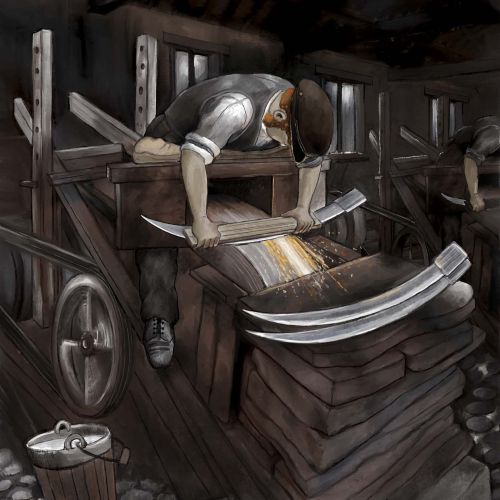Heritage artwork at the Globe Works: The Grinder
Discover the story behind the artwork

Created by Wessex Archaeology in 2022, these panels were commissioned by the Globe Works to commemorate the outstanding and unique heritage of the building and depict people and scenes from its industrial past.
In order to create a cutting edge to a blade, it was passed on to the grinder.
Local sandstone provided the grinders with their grinding wheels, with different size wheels used for different products and/or specialisms. By the 1900s, sandstone was phased out and replaced by carborundum.
Grinding wheels were hung on spindles over troughs of water set in the floor. The grinder would sit over his grinding wheel astride a wooden ‘horsing’ which was supported above the trough on a wooden framework. The grinding wheel was driven by a long leather belt, connecting a wooden pulley attached to one end of the spindle, to a drum on the line shaft powered from the engine. The stone would revolve away from the grinder, whilst he would hold the blade with a ‘flatstick’, resting his elbows on his knees. In order to apply greater pressure on the blade, the grinder would stand and put his whole body weight onto the blade. The blade was held against the stone using the flatstick to protect the grinder’s fingers and to help him control the process.
A 42in diameter grinding wheel would revolve at 250-300 rpm, giving a surface speed of 3000 feet per minute. This was considered the optimum, although they could be driven faster. The faster the rotation, the faster the grinder could work. However, the increased heat in the blade caused by the friction could damage the temper of the steel, whilst there was also an increased risk of the wheel breaking.
When the stone became too smooth to be effective it was roughened with an ‘racing iron’ and if it wore out of true it was dressed back into shape by hitting the grinding face with a hackhammer. The stones were used until they were reduced to half their original size. At this point, they were either sold on to other grinders requiring smaller stones, or used for building material around the works. These redundant stones were known as ‘cokes’.
Once the blade had been ground, they were dried and then glazed to give a smooth, semi-polished finish to prevent rust using a glazer. A glazer was a wooden wheel of similar diameter, with a typically two-inch wide edge, which was covered in leather. The leather was coated with fish glue and rolled in varying sizes of emery grit. This process would improve the coarser finish from the sandstone wheel, with the blade potentially going through further, finer glazing processes.
Sources include:
- Unwin, J. The Development of the Cutlery and Tableware Industry in Sheffield (2002). In J. Symonds (Eds.), ARCUS Studies in Historical Archaeology 1 - The Historical Archaeology of the Sheffield Cutlery and Tableware Industry 1750-1900 (pp. 13-52).
- Unwin, J & Hawley, K. (2005) Sheffield Industries. Cutlery, Silver and Edge Tools. Tempus
- Wray, N. (2000). ‘One Great Workshop’. The Buildings of the Sheffield Metal Trades. English Heritage.
- Dawson, L. (2005) Watching Brief Report at the Lancaster Complex, Ball Street, Neepsend, Sheffield, South Yorkshire. ARCUS. Report ref. 754c.3
